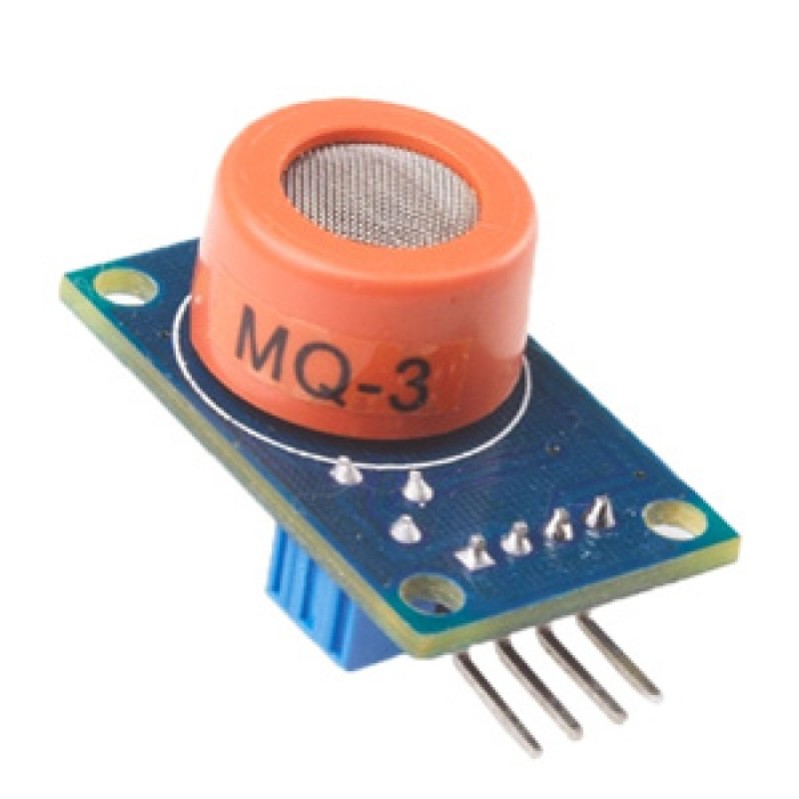
.jpeg&width=620&quality=80)


.jpeg&width=172&quality=80)


.jpeg&width=300&quality=80)

MQ3 GAS SENSOR MODULE
The Grove - Gas Sensor(MQ3) module is useful for gas leakage detection (in home and industry). It is suitable for detecting Alcohol, Benzine, CH4, Hexane, LPG, CO. Due to its high sensitivity and fast response time, measurements can be taken as soon as possible.
₹ 154 ₹199
199



| Made In : | India |
Add FAQ
nsor Module Overview:
1. Key Features:
-
Gas Sensor:
- The MQ3 sensor is a metal oxide semiconductor (MOS) type that detects gases through changes in its resistance. It is particularly sensitive to alcohol and can also detect other gases like CO and NH3.
-
Heating Element:
- The sensor includes a heating element that maintains the required temperature for the sensing material to operate effectively. This ensures accurate gas detection.
-
Analog Output:
- Provides an analog voltage output proportional to the concentration of the detected gas. This output can be read by an analog-to-digital converter (ADC) or a microcontroller.
-
Digital Output (Optional):
- Some modules have a digital output that can signal when gas concentration exceeds a predefined threshold. This output is useful for triggering alarms or alerts.
2. Working Principle:
-
Gas Detection:
- The MQ3 sensor detects gases based on changes in the resistance of its sensing element. When exposed to gases, the resistance of the sensing material changes, which is then converted into a voltage signal.
-
Heating Process:
- The built-in heater heats the sensing element to ensure it operates at a stable temperature, allowing for consistent and reliable gas detection.
-
Output Signal:
- The analog output signal varies with the concentration of the target gas. This voltage can be measured and converted into gas concentration values using calibration data.
3. Circuit Connections:
-
Power Supply:
- The MQ3 module typically operates at 5V DC. Connect the VCC pin to a 5V power source and the GND pin to ground.
-
Analog Output:
- Connect the analog output pin (A0) to an analog input pin on a microcontroller or ADC to measure gas concentration.
-
Digital Output (if available):
- If the module has a digital output pin (D0), it can be connected to a digital input pin on the microcontroller. This pin can be used to trigger an alarm or alert when the gas concentration exceeds a certain threshold.
-
Heater Control:
- Some modules may have a specific control pin for the heater. Refer to the module's datasheet for connection details.
4. Applications:
-
Breathalyzer Devices:
- Commonly used in breathalyzers to detect alcohol levels in the breath, helping to measure blood alcohol concentration (BAC).
-
Air Quality Monitoring:
- Employed in systems to monitor indoor air quality by detecting the presence of gases and pollutants.
-
Gas Leak Detection:
- Used in safety systems to detect gas leaks in industrial or residential settings.
-
Environmental Monitoring:
- Applied in environmental monitoring systems to track gas concentrations and ensure safe air quality levels.
5. Calibration:
-
Initial Calibration:
- Perform initial calibration by exposing the sensor to clean air to establish a baseline reading for zero gas concentration.
-
Gas Concentration Calibration:
- For accurate gas concentration measurement, calibrate the sensor with known concentrations of the target gases. This involves creating a calibration curve based on the sensor's response to known gas levels.
6. Advantages:
-
Versatility:
- Sensitive to multiple gases, including alcohol, CO, and NH3, making it suitable for various applications.
-
Cost-Effective:
- Provides an affordable solution for gas detection and air quality monitoring.
-
Ease of Integration:
- Simple to integrate with microcontrollers and development boards due to its analog and optional digital outputs.
7. Limitations:
-
Sensitivity to Interference:
- The sensor may be affected by other gases or environmental factors, which can impact accuracy. Calibration is crucial for reliable readings.
-
Warm-Up Time:
- The sensor may require a warm-up period to stabilize and provide accurate readings.
-
Limited Lifespan:
- The sensing material can degrade over time, affecting the sensor’s performance and accuracy.
8. Example Use Case:
Breathalyzer Device:
- In a breathalyzer device, the MQ3 sensor is used to measure the alcohol concentration in a person’s breath. The sensor captures the alcohol vapors, and its resistance changes accordingly. The analog output is then processed by a microcontroller to calculate the BAC and display the result.
Summary:
The MQ3 gas sensor module is a versatile and cost-effective tool for detecting and measuring various gases. Its sensitivity to alcohol and other gases makes it suitable for a range of applications, from breathalyzers to air quality monitoring systems. Proper calibration and understanding of the sensor’s limitations are essential for accurate and reliable performance.

import spidev
import time
# Set up SPI communication with MCP3008
spi = spidev.SpiDev()
spi.open(0, 0) # Open SPI bus 0, chip select 0
spi.max_speed_hz = 1350000 # Set SPI speed
# Function to read data from MCP3008 ADC
def read_adc(channel):
if channel < 0 or channel > 7:
return -1 # Invalid channel
adc = spi.xfer2([1, (8 + channel) << 4, 0]) # Send request to MCP3008
result = ((adc[1] & 3) << 8) + adc[2]
return result
# Function to calculate the gas concentration (arbitrary units)
def calculate_gas_concentration(adc_value, reference_voltage=3.3, adc_max_value=1023):
# The ADC value is scaled from 0 to 1023. We map this value to a gas concentration.
# Adjust this formula based on your calibration and sensor datasheet.
gas_concentration = (adc_value / adc_max_value) * reference_voltage
return gas_concentration
# Main loop to read and display gas sensor values
try:
while True:
# Read the analog value from the MQ-3 sensor (connected to channel 0)
adc_value = read_adc(0)
# Calculate the gas concentration (you can customize the formula)
gas_concentration = calculate_gas_concentration(adc_value)
# Print the results
print(f"Raw ADC Value: {adc_value}")
print(f"Gas Concentration: {gas_concentration:.2f} V")
# Wait a bit before the next reading
time.sleep(1)
except KeyboardInterrupt:
print("Program interrupted.")
finally:
spi.close() # Close the SPI communication
0 Reviews For this Product












.jpg&width=225&quality=80)
